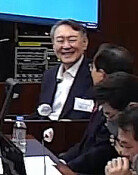Do Performance Assessments Improve Creativeness or Copy Ability?
Do Performance Assessments Improve Creativeness or Copy Ability?
Posted April. 24, 2005 23:44,
Kim, living in Jeongja-dong, Bundang-gu, Seongnam-si, Gyeonggi-do, became speechless after seeing her child, a third-grade student in middle school, copying an entire evaluation section of one chapter in a textbook as homework for performance assessment in the Korean language. To copy the section into three or four large pieces of paper required several hours. This is far from something creative; rather, it would be closer to practice in copying. I cant understand why teachers ask students to do this, said Kim. The performance assessment, which has been implemented since 1999 in elementary, middle, and high schools, is being haunted by a number of problems, despite its good initiative.
Even though the educational authority obliges schools to inform students of evaluation criteria, assessment plans, and its content early in the semester, there are many who notify them just two or three weeks before midterm examinations. Some even evaluate students on the basis of what they didnt teach, and require students to carry out impossible tasks. There was one case in a middle school located in Gangnam, Seoul, that, responding to a physical education teachers instruction to hit tennis balls 50 times into a wall, students resisted by saying, How could we do what teachers cant do?
Han, 40, living in Seocho-dong, Seocho-gu, Seoul, who has a third-grade middle school child, said, Even though my son is not good at physical exercise, he always tries to do his best. The problem in the performance assessment is that it places more weight on outcomes than process.
Kim Yu-huin, 14, a second-year middle school student, said, When teachers use how well I take notes in courses as an evaluation tool, an unfair evaluation might disadvantage me if I write with bad handwriting.
Lee, 43, living in Daechi-dong, Gangnam-gu, Seoul, who has a first-year high schooler, said, Compared to girl students, boy students tend to write badly and less meticulously. Girls, therefore, do much better in playing musical instruments. Lee also added, Nowadays, parents are very sensitive to the performance assessment because it is reflected in school grades.
Because of this, while parents of girl students prefer coeducational schools, parents of boy students are reluctant to send their kids to this type of school. The trend is particularly noticeable in the Gangnam area in Seoul. The reason is that boy students, who tend to be less meticulous than girls, are more likely to receive low grades in school. No boy student has taken the top 10 places in a school, for example.
Kim Bu-yeong, 15, a student at Jinseon girls middle school, said, Since the most of the evaluations are based on teamwork, those who dont work very hard can receive the same grade as those who work hard. It is not fair.
Park, 42, living in Dogok-dong, Gangnam-gu, Seoul, who has a second-grade high schooler, said, After homeroom teachers are decided, parents who have access to information on which courses teachers selected last year for performance assessments employ a private tutor for preparing their kids for that course. Lee also added, As for fine arts courses, I have seen one who presents work that was painted by teachers in private institutions as homework for performance assessments.
Lee, 15, a third-year middle school student, said, I heard that a teacher evaluates a fine art course on the basis of how similar a self-portrait is to oneself. Thus, I presented what I drew in a private institution with the help of instructors. Even though the teacher seemed to have noticed that, she didnt take it seriously.
Regarding performance assessments, school teachers are also suffering from difficulties. Choi Yong-ju, the vice principal of Inchang High School in Seoul, said, It is practically impossible to develop the original initiative of performance assessment because we have to cover too many students at the same time, adding, I know one Chinese writing teacher who teaches roughly 700 students in 20 classes.




![지하철 타고 가는 북한산성…외국인도 반한 ‘K등산 맛집’[전승훈 기자의 아트로드]](https://dimg.donga.com/c/138/175/90/1/wps/NEWS/IMAGE/2026/01/10/133120824.1.jpg)


